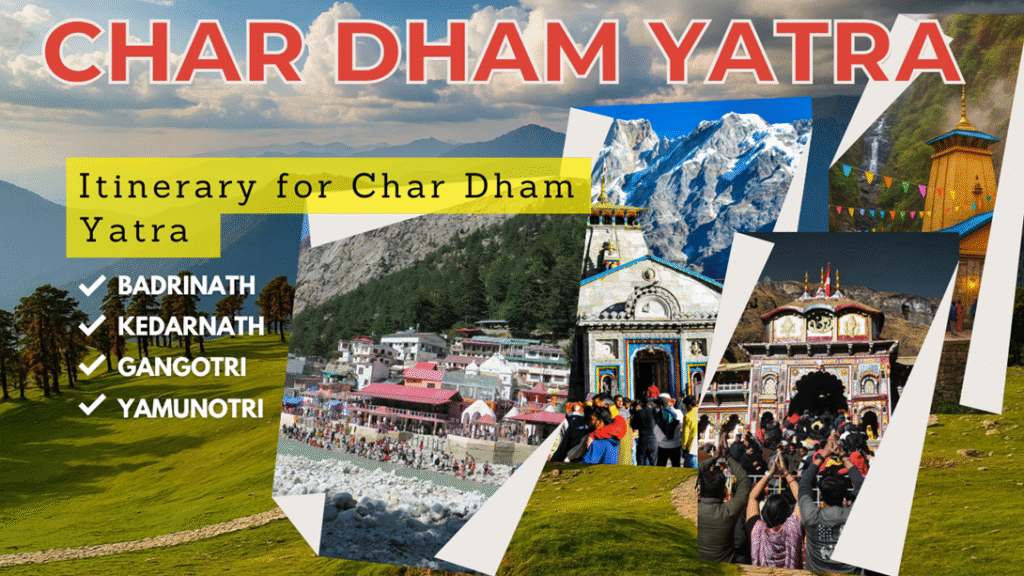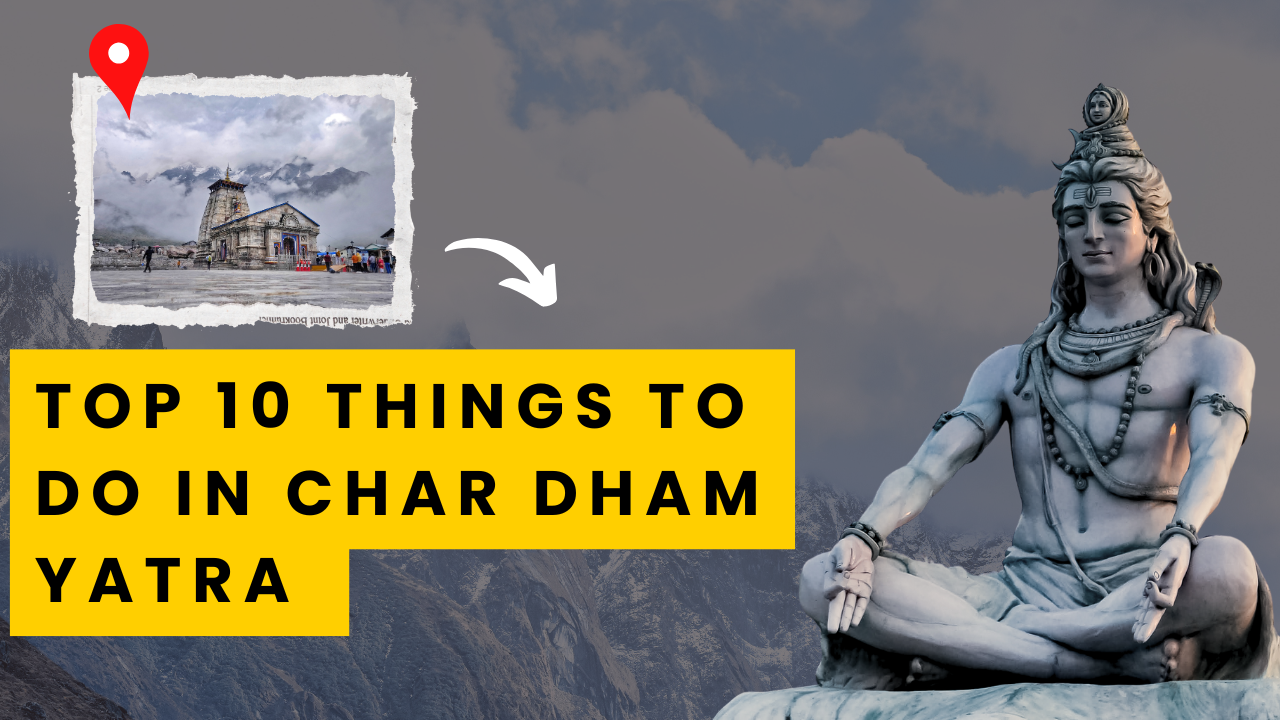Understanding Char Dham Yatra
The word “Char Dham” is made up of two Hindi words — Char meaning four and Dham meaning temple or holy place. Therefore, Char Dham Yatra means the sacred journey to four divine shrines of India.
Interestingly, India has two types of Char Dham pilgrimages. The first is the Main Char Dham, which includes Badrinath in Uttarakhand, Dwarkadhish in Gujarat, Jagannath Puri in Odisha, and Rameshwaram in Tamil Nadu. Each of these temples represents one direction of the country — north, west, east, and south — symbolizing the spiritual unity of India.
However, the second type, known as the Chota Char Dham Yatra, is located entirely in Uttarakhand. This smaller yet spiritually powerful circuit attracts millions of pilgrims every year. Moreover, this Himalayan Char Dham includes Yamunotri, Gangotri, Kedarnath, and Badrinath, each holding deep mythological and cultural importance.
You can also read our travel guide on Hidden Gems of Uttarakhand to explore lesser-known spiritual spots in the Himalayas.
The Himalayan Char Dham – A Journey of Faith
The Chota Char Dham Yatra unfolds through the Garhwal region of Uttarakhand, offering not only spiritual enlightenment but also breathtaking natural beauty.
To begin with, the journey starts at Yamunotri, dedicated to Goddess Yamuna — believed to grant longevity and freedom from untimely death. Next comes Gangotri, where Goddess Ganga descended from heaven to cleanse humanity’s sins.
After that, the path leads to Kedarnath, one of the twelve Jyotirlingas of Lord Shiva, where pilgrims often carry holy water from Gangotri to offer to the deity. Finally, the yatra concludes at Badrinath, devoted to Lord Vishnu, representing salvation and peace.
Furthermore, each destination carries a unique story and spiritual vibration that deepens your connection with faith. It’s not just a route — it’s a path toward awakening.
For updated temple timings and route maps, visit the official Uttarakhand Tourism website.
1. Follow the Trail of Myths and Legends
Every temple in the Char Dham Yatra is rooted in ancient mythology. For example, Kedarnath is believed to be the place where the Pandavas sought Lord Shiva’s forgiveness after the Mahabharata war. Similarly, at Yamunotri, Goddess Yamuna is worshipped as the sister of Yama, the God of Death, and it is believed that bathing here ensures liberation from the fear of death.
In addition, listening to these fascinating legends from local priests and villagers adds depth and wonder to your spiritual journey. As you travel, you realize that every mountain, river, and stone here has a story to tell.
You may also like our blog on Is Rishikesh Just for Yoga? 10 Other Things You Didn’t Know You Could Do for exploring more spiritual activities in Uttarakhand.
2. Participate in Sacred Rituals
While visiting these temples, don’t just observe — participate in the rituals.
At Badrinath, many devotees perform Pind Daan or Shraddha rituals for their ancestors. Meanwhile, at Gangotri, people offer Tarpan to honor their departed loved ones in the sacred waters of the Ganga.
Moreover, these age-old traditions bring emotional healing. They remind us that spirituality is not only about worshiping deities but also about staying connected to our roots and expressing gratitude for our lineage.
3. Discover Hidden Temples and Spots
Beyond the four main shrines, several hidden gems await exploration.
For instance, near Yamunotri, lies the Shani Dev Temple, known for its tranquil surroundings. Likewise, near Badrinath, you can visit Vasudhara Falls, where the cascading waters are believed to purify the soul.
Additionally, visiting such lesser-known places gives you moments of peace away from the crowd, allowing you to connect deeply with nature and yourself.
4. Serve at Langars – The Joy of Seva
Along the entire Char Dham route, you’ll find numerous langars (community kitchens) serving free meals to pilgrims.
Volunteering at these langars — whether by cooking, serving food, or cleaning utensils — is a deeply humbling experience. It teaches you that seva (service) is another form of worship. Furthermore, helping others fills your heart with warmth and gratitude, reminding you that spirituality is best expressed through kindness.
You can find volunteer opportunities listed on Badrinath-Kedarnath Temple Committee’s official website.
5. Explore the Origin of Sacred Rivers
The Char Dham Yatra is not only about temples; it’s also about the rivers that give life to India.
You can trek to Gaumukh Glacier, the origin of the River Ganga, or explore Saptrishi Kund, the source of the Yamuna River. These high-altitude treks are challenging yet profoundly rewarding.
In addition, witnessing these origins helps you appreciate how faith and nature coexist. The sound of gushing waters and the sight of majestic peaks together create a moment of divine realization.
6. Chant Mantras by the Rivers
At dusk, sit beside the riverbanks and chant “Om Namah Shivaya” or the Gayatri Mantra.
The soothing sound of flowing rivers, the ringing temple bells, and the crisp mountain air together create an atmosphere of peace. Moreover, such meditation connects your soul with the divine energy that surrounds you.
7. Admire Himalayan Flora and Fauna
The Char Dham route passes through valleys filled with vibrant Himalayan flora and fauna.
You may encounter the Brahma Kamal, Uttarakhand’s state flower, near Badrinath, or spot Himalayan Monals and Musk Deer in higher regions. In addition, during spring, the entire valley blooms in shades of pink, yellow, and green, making the journey even more enchanting.
Thus, the pilgrimage becomes a perfect balance between spiritual awakening and natural wonder.
Learn more about the region’s biodiversity at Valley of Flowers National Park (UNESCO)
8. Join Eco-Friendly Activities
Since thousands of devotees visit every year, maintaining cleanliness is crucial.
Several local groups and NGOs organize clean-up drives and tree-planting campaigns along the yatra route. Participating in these initiatives is a small act with a big impact. Moreover, by contributing to nature’s preservation, you ensure that future generations experience the same serenity and beauty.
9. Meet the Himalayan Sages
Throughout your journey, you may come across sages and hermits meditating in caves or living in solitude near the temples.
Speaking with them offers insights into simple living and deep spirituality. Their words often hold timeless wisdom about life, peace, and purpose. As a result, many pilgrims find a renewed sense of direction after meeting these enlightened souls.
10. Gaze at the Starry Himalayan Sky
Finally, when you reach Kedarnath or Gangotri, take a moment at night to look up at the sky.
The sight of thousands of stars shining over snow-covered peaks feels magical. Furthermore, the silence of the mountains adds a sense of infinity, reminding you of your small yet beautiful place in the universe.

Char Dham Yatra Itinerary
Day 1: Haridwar – Barkot (196 KM / 6–7 HRS)
- Arrive in Haridwar and drive to Barkot.
- Enjoy scenic views along the Yamuna River.
- Check in, have dinner, and rest for the next day.
Day 2: Barkot – Janki Chatti – Yamunotri – Barkot (45 KM by road & 6 KM trek)
- Drive to Yamunotri Dham, the origin of River Yamuna.
- Reach Janki Chatti, trek 6 km or take a pony/palki.
- Bathe in Surya Kund’s hot water, offer prayers at Yamuna Ji Temple, and return to Barkot.
Day 3: Barkot – Uttarkashi (85 KM / 4 HRS)
- Drive to Uttarkashi, a spiritual town on the Bhagirathi River.
- Visit Shiv Gufa on the way.
- Evening visit to Kashi Vishwanath Temple, dinner, and overnight stay.
Day 4: Uttarkashi – Gangotri – Uttarkashi (100 KM / 4 HRS one way)
- Drive to Gangotri via Harshil Valley.
- Take a dip in the holy Ganges, perform puja, and return to Uttarkashi.
Day 5: Uttarkashi – Guptkashi/Sonprayag (220 KM / 7–8 HRS)
- Travel towards Guptkashi, enjoying views of the Bhagirathi and Mandakini Rivers.
- Check-in, dinner, and overnight stay.
Day 6: Guptkashi/Sonprayag – Kedarnath (22 KM trek one way)
- Reach Kedarnath by trekking or helicopter.
- Participate in puja and evening aarti.
Day 7: Kedarnath – Guptkashi/Sonprayag (22 KM trek one way)
- Morning darshan and puja at Kedarnath.
- Return to Guptkashi by trek or helicopter.
Day 8: Guptkashi/Sonprayag – Badrinath (184 KM / 6–7 HRS)
- After breakfast, head to Badrinath.
- Attend darshan and evening aarti, dinner, and rest.
Day 9: Badrinath – Haridwar (250 KM / 8 HRS)
- Take a dip in Tapt Kund and visit Mata Murti Temple, Bhim Pul, Vyas Gufa, Narad Kund, and Mana Village.
- Perform Pind Daan Shraddh at Brahamakapal.
- Drive back to Haridwar via Devprayag.
- The yatra concludes on arrival.
Conclusion
In conclusion, the Char Dham Yatra is far more than just a religious journey — it’s a path of discovery, emotion, and transformation.
From participating in sacred rituals to serving at langars, from trekking to the river origins to stargazing under the Himalayan sky — every experience leaves a mark on your heart.
Therefore, whether you seek faith, adventure, or inner peace, this yatra offers it all. Eventually, you’ll realize that the true pilgrimage lies not just in reaching the temples but in the transformation you undergo along the way.






